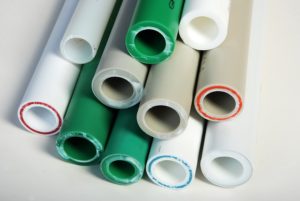 Industrial machines for plastic are used to manufacture a wide range of end products and consumer goods. When it comes to plastic manufacturing, there are different types of plastic which could be used for further production. In this series of articles, we’re getting familiar with a variety of plastic types starting with Polypropylene.
Industrial machines for plastic are used to manufacture a wide range of end products and consumer goods. When it comes to plastic manufacturing, there are different types of plastic which could be used for further production. In this series of articles, we’re getting familiar with a variety of plastic types starting with Polypropylene.
Polypropylene (PP)
Polypropylene (PP) is a strong and rigid, crystalline thermoplastic polymer, obtained from monomeric propylene. Polypropylene is a linear hydrocarbon polymer with the chemical formula (C3H6)n. Nowadays, polypropylene is one of the cheapest of all available plastics, it also has the lowest density.
Used plastic machines for sale
Polypropylene – the area of use
Polypropylene is widely used in various fields due to its high chemical resistance and good weldability.
1. Production of packaging: good barrier properties, high strength, good surface quality and low cost allow the use of polypropylene in the production of packaging.
a) Flexible packaging: PP films have good optical properties and low permeability to water vapor, which allows them to be used for food packaging. Polypropylene also produces shrink wrapping films, films for the electronics industry, films for drawing graphics images, elements of disposable diapers, lids, etc. PP films are obtained either in the form of flat-slip films (Cast Film) or in the form of biaxially oriented polypropylene films (BOPP, BOPP).
b) Rigid packaging: from polypropylene by blow molding, containers (boxes), bottles and containers are produced. Thin-walled polypropylene containers are commonly used for food packaging.
2. Consumer goods: polypropylene is used in the production of certain components of household appliances and consumer goods, in particular, transparent parts, household items, furniture, appliances, toys, etc.
3. Automotive: due to its low cost, and also due to its good mechanical properties and good processability, polypropylene is widely used in the production of auto components. The material, in particular, is used in the manufacture of battery housings, pallets, bumpers, side moldings, interior trim elements, instrument panels and door trim elements. Important properties of PP, which allow it to be used in the automotive industry, are also a low value of the coefficient of linear thermal expansion, low specific gravity, high chemical resistance, good weather resistance, processability and a ratio of toughness and rigidity.
4. Fibers and fabrics: a large number of PP is used in the fiber and tissue segment. PP fibers are used in the production of tapes (obtained as a result of cutting films), strips, belts, volumetric continuous threads, staple fibers, spun bond material and continuous yarns. Ropes, ropes, and twine from PP have high strength and resistance to moisture, which allows them to be used in shipbuilding.
5. Medicine: polypropylene is used for the production of various medical products due to its high chemical resistance and resistance to the action of bacteria. In addition, the medical grades of PP have a high resistance in conditions of steam sterilization. Disposable syringes are the most typical medical device produced from polypropylene. The material is also used to produce medical tubes, diagnostic devices, Petri dishes, intravenous infusion bottles, sample bottles, food containers, trays, tablet containers, etc.
6. Industry: polypropylene sheets are widely used in the industrial sector for the production of acid and chemical reactants, sheets, pipes, multi-turn transport packaging and packaging (RTP), etc. This is because the material has a high strength, resistance to high temperatures and corrosion resistance.
Processing conditions for polypropylene
Polypropylene can be processed into products by virtually any method of plastic processing. The most typical methods of processing polypropylene are injection molding, extrusion blow molding, extrusion of general purpose.
1. Injection molding
– Melt temperature: 200-300 ° C
Form temperature: 10-80 ° C
– If stored properly, the material does not need to be dried before processing
– At a high mold temperature, the gloss level increases and the appearance of the products obtained improves
– The degree of shrinkage of the material in the mold is from 1.5 to 3%, depending on the processing conditions, the rheological characteristics of the polymer and the wall thickness of the molded article
2. Extrusion (pipes, inflatable and planar films, insulation on cables and wires, etc.)
– Melt temperature: 200-300 ° C
– The compression ratio of the material: 3: 1
– Material cylinder temperature: 180-205 ° C
– Pre-drying: not required. The secondary material must be dried for 3 hours at a temperature of 105-110 ° C (221-230 ° F)
3. Blow molding (extrusion followed by blowing)
4. Compression molding (pressing)
5. Rotational molding
6. Injection-blow molding
7. Extrusion blow molding
8. Oriented injection-blow molding
9. Extrusion of general purpose
A special process can also produce foamed polypropylene (PPV). The material is well processed by injection molding, and it is widely used in both batch and continuous processes.
Thank you for reading our articles, stay informed about the industrial world and Exapro by following us on Exapro Hub, Facebook, Twitter and LinkedIn.



